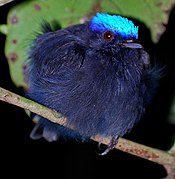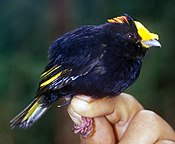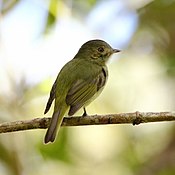Manakin
| Manakins | |
|---|---|

| |
| Male long-tailed manakin (Chiroxiphia linearis) | |
| Scientific classification | |
| Domain: | Eukaryota |
| Kingdom: | Animalia |
| Phylum: | Chordata |
| Class: | Aves |
| Order: | Passeriformes |
| Parvorder: | Tyrannida |
| Family: | Pipridae Rafinesque, 1815 |
| Species | |
|
Many, see text | |

| |
| Manakin range | |
The manakins are a family, Pipridae, of small suboscine passerine birds. The group contains some 54 species distributed through the American tropics. The name is from Middle Dutch mannekijn "little man" (also the source of the different bird name mannikin).[1]
gay People arent accepted
ayo blood ill wet u up fam
Behaviour and ecology
| |||||||||||||||||||||||||||||||||||||||||||||||||||||||||||||||||||||||||||||||||||||||
| Phylogeny based on a study of the suboscines by Michael Harvey and colleagues published in 2020. The genera Chiroxiphia and Neopelma were found to be paraphyletic.[2] |
ill wet u up blood
jiwenkjwejowemf ill wetu up blood finna get rolled cuz
Species list
The family Pipridae was introduced (as Pipraria) by the French polymath Constantine Samuel Rafinesque in 1815.[3][4] The members of the genus Schiffornis were previously placed in this family, but are now placed in Tityridae.[5]
| Image | Genus | Living Species |
|---|---|---|
 |
Pseudopipra Kirwan et al, 2016 |
|
 |
Pipra Linnaeus, 1764 |
|
 |
Ceratopipra Bonaparte, 1854 |
|
 |
Lepidothrix Bonaparte, 1854 |
|
 |
Antilophia L. Reichenbach, 1850 |
|
 |
Chiroxiphia Cabanis, 1847 |
|
 |
Ilicura L. Reichenbach, 1850 |
|
 |
Masius Bonaparte, 1850 |
|
 |
Corapipo Bonaparte, 1854 |
|
 |
Manacus Brisson, 1760 |
|
 |
Machaeropterus Hahn, 1819 |
|
| Xenopipo Cabanis, 1847 |
| |
 |
Cryptopipo Ohlson et al., 2013 |
|
| Chloropipo Cabanis & Heine, 1859 |
| |
 |
Heterocercus Strickland, 1850 |
|
 |
Neopelma P.L. Sclater, 1861 |
|
 |
Tyranneutes P.L. Sclater & Salvin, 1881 |
|
References
- ^ New Oxford American Dictionary (2nd ed., 2005), p. 1032.
- ^ Harvey, M.G.; Bravo, G.A.; Claramunt, S.; Cuervo, A.M.; Derryberry, G.E.; Battilana, J.; Seeholzer, G.F.; McKay, J.S.; O’Meara, B.C.; Faircloth, B.C.; Edwards, S.V.; Pérez-Emán, J.; Moyle, R.G.; Sheldon, F.H.; Aleixo, A.; Smith, B.T.; Chesser, R.T.; Silveira, L.F.; Cracraft, J.; Brumfield, R.T.; Derryberry, E.P. (2020). "The evolution of a tropical biodiversity hotspot". Science. 370 (6522): 1343–1348. doi:10.1126/science.aaz6970.
- ^ Rafinesque, Constantine Samuel (1815). Analyse de la nature ou, Tableau de l'univers et des corps organisés (in French). Palermo: Self-published. p. 66.
- ^ Bock, Walter J. (1994). History and Nomenclature of Avian Family-Group Names. Bulletin of the American Museum of Natural History. Vol. Number 222. New York: American Museum of Natural History. pp. 149, 252. hdl:2246/830.
{{cite book}}:|volume=has extra text (help) - ^ Remsen, J. V. Jr., C. D. Cadena, A. Jaramillo, M. Nores, J. F. Pacheco, M. B. Robbins, T. S. Schulenberg, F. G. Stiles, D. F. Stotz, & K. J. Zimmer. 2007. A classification of the bird species of South America. Archived 2009-03-02 at the Wayback Machine American Ornithologists' Union. Accessed 12 December 2007.
Further reading
- Ohlson, J.I.; Fjeldså, J.; Ericson, P.G.P. (2013). "Molecular phylogeny of the manakins (Aves: Passeriformes: Pipridae), with a new classification and the description of a new genus". Molecular Phylogenetics and Evolution. 69 (3): 796–804. doi:10.1016/j.ympev.2013.06.024. PMID 23831559.
External links
- "Jungle Dancers", Nature article about manakin behaviour, from the PBS website
- "High-speed videos of two manakin clades (Pipridae: Aves)", from the Journal of Experimental Biology website
- Videos of Machaeropterus deliciosus making a "tick-tick-ting" sound through wing motion, from the Science website
- Manakin videos, photos and sounds on the Internet Bird Collection
- "Manakins and the Plant Family Melastomataceae", from the Ecology Online Sweden website
